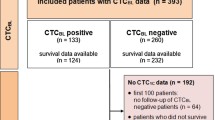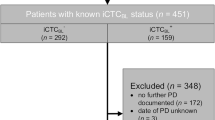Abstract
Background
Evaluating circulating tumor cells (CTCs) is one way to predict outcome and monitor treatment in patients with MBC. In this prospective study, we evaluated CTCs in predicting treatment efficacy and overall survival (OS) using the CellSearch™ System (Veridex, LLC, Raritan, NJ).
Methods
One hundred nineteen patients with MBC with measurable disease were enrolled. Samples of 7.5 ml of blood from 107 eligible patients were tested for CTCs before starting therapy (baseline), after one cycle of therapy (3–4 weeks) and at 12 weeks. We compared CTC levels and imaging at baseline and at 12 weeks. Next, we determined the hazard ratios (HR) by comparing cases with zero CTCs to those with one or more CTCs. Moreover, HR was calculated when comparing cases that had greater than or equal to a certain number of CTCs to those with less than the number of CTCs.
Results
This study shows the incidence of detection of CTCs in patients with metastatic breast cancers. Of the patients, 64.4% (76/118) had one or more CTCs, and 37.3% (44/118) had five or more CTCs. First we set the baseline number of CTCs as 100%. Of the seven cases whose level of CTCs decreased more than 90%, six (85.7%) demonstrated a positive response (complete response and partial response) by imaging after one cycle (3–4 weeks later). For the patients whose CTC levels increased above 100% after one cycle (3–4 weeks later), 7 of 11 (63.6%) had progressive disease (PD). The HR for cases with five to ten CTCs was greater than 1.00 [HR = 2.450; 95% confidence interval (CI) 0.727–8.248]. Statistical significance was observed when comparing patients who had ≥3 CTCs to those with <3 CTCs (P = 0.0273). When comparing cases with ≥5 CTCs to those with <5 CTCs, the hazard ratio was 3.069 (95% CI 1.496–6.295; P = 0.0022).
Conclusions
Because the change in the number of CTCs was highly correlated with results from imaging before and after therapy, CTCs can be considered a biomarker that may predict the effect of treatment earlier than imaging modalities.

Similar content being viewed by others
References
Jemal A, Murray T, Ward E, Samuels A, Tiwari RC, Ghafoor A, et al. Cancer statistics, 2005. CA Cancer J Clin. 2005;55:10–30.
Ellis MJ, Hayes DF, Lippman ME. Treatment of metastatic breast cancer. In: Harris JR, Lippman ME, Morrow M, Osborne CK, editors. Diseases of the breast. 2nd ed. Philadelphia: Lippincott; 1999. p. 749–97.
Yagata H, Nakamura S, Toi M, Bando H, Ohno S, Kataoka A. Evaluation of circulating tumor cells in patients with breast cancer: multi-institutional clinical trial in Japan. Int J Clin Oncol. 2008;13:252–6.
Cristofanilli M, Budd GT, Ellis M, Stopeck A, Matera J, Miller MC, et al. Circulating tumor cells, disease progression, and survival in metastatic breast cancer. N Engl J Med. 2004;351:781–91.
Cristofanilli M, Hayes DF, Budd GT, Ellis MJ, Stopeck A, Reuben JM, et al. Circulating tumor cells: a novel prognostic factor for newly diagnosed metastatic breast cancer. J Clin Oncol. 2005;23:1420–30.
Rao CG, Chianese D, Doyle GV, Miller MC, Russell T, Sanders RA Jr, et al. Expression of epithelial cell adhesion molecule in carcinoma cells present in blood and primary and metastatic tumors. Int J Oncol. 2005;27:49–57.
Kagan M, Howard D, Bendele T, Rao C, Terstappen LWMM. A sample preparation and analysis system for identification of circulating tumor cells. J Clin Lig Assay. 2002;25:104–10.
Kagan M, Howard D, Bendele T, Rao C, Terstappen LWMM. Circulating tumor cells as cancer markers, a sample preparation and analysis system. In: Diamandis EP, Fritsche HA, Lilja H, Chan DW, Schwartz M, editors. Tumor markers: physiology, pathobiology, technology, and clinical applications. Washington: AACC Press; 2002. p. 495–8.
Budd GT, Cristofanilli M, Ellis MJ, Stopeck A, Borden E, Miller MC, et al. Circulating tumor cells versus imaging-predicting overall survival in metastatic breast cancer. Clin Cancer Res. 2006;12:6403–9.
Acknowledgments
This study was sponsored and designed by the sponsor (Ortho-Clinical Diagnostics KK, Tokyo, Japan) in collaboration with clinical investigators. Data on CTCs were also collected and verified by the sponsor.
Author information
Authors and Affiliations
Corresponding author
About this article
Cite this article
Nakamura, S., Yagata, H., Ohno, S. et al. Multi-center study evaluating circulating tumor cells as a surrogate for response to treatment and overall survival in metastatic breast cancer. Breast Cancer 17, 199–204 (2010). https://doi.org/10.1007/s12282-009-0139-3
Received:
Accepted:
Published:
Issue Date:
DOI: https://doi.org/10.1007/s12282-009-0139-3




